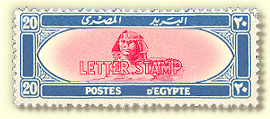

 On March 1st 1936 the NAAFI labels were replaced by formal Egyptian stamp of 10 mill in red bearing the portrait of King Fuad The new stamps were to be sold in the same way, but they no longer needed to be placed on the backs of letters and to be accompanied by a separate franking handstamp. A 3m. green stamp in the same design was issued on December 1st 1936 for use on holiday greetings; it was temporarily withdrawn from sale on February 15th 1937, to be placed on sale again in December 1937 until February 1938 and in December 1938 until February 1939. Both stamps were produced by the Survey Department of Egypt by photogravure. They were printed in sheets of 100 on paper watermarked crown and Arabic fa', perforated 13½x14. After the death of King Fuad stamps showing King Farouk were issued. The new stamps were issued on December 16th 1939 in the same design as before, but in a smaller size and perf. 13½ . Initially, use of the Army Post stamps was subject to the same restrictions as had applied to the NAAFI stamps. However, with the outbreak of war between Britain and the Axis Powers and the arrival of army and air force contingents from Dominions and Colonies, Army Post stamps were permitted to be used to pay for air mail. The rate was 40m. (a reduction from the civilian rate of 60m.) which could be paid either with four Army Post stamps or a single in combination with a 30m. ordinary stamp (usually the 30m. air mail stamp) The restriction of the destination was also removed and many letters franked with Army Post stamps were sent to the several Dominions. The requirement that soldiers' letters be posted in military letter boxes to qualify for the reduced rate became an irksome source of confusion when offices began to be moved about as military preparations increased. This resulted in many letters being charged postage due, and consequent to that, many complaints being made. Eventually, the British GPO decided not to charge postage due on Army Post letters, regardless of the office of posting. The stamps of the King Farouk reign did not render the King Fuad stamps obsolete and they continued to be used even into 1941. However, free-franking for surface letters was introduced on November 1st 1940 and thereafter the Army Post stamps were only useful for air mail and possibly for letters to destinations for which the free franking privilege did not apply. The King Farouk 3m. shortly after it was put on sale it became redundant because of the introduction of surface free franking. Most Christmas greetings would not have been posted until long after November 1st and only those to distant destinations, especially Australia and New Zealand, were posted before then. Consequently, this stamp is truly rare on legitimate covers and is very difficult to find used with a proper cancellation (some were cancelled to order at a later date with Cairo or Field Post Office date-stamps). Besides use on simple greeting cards, there were three other ways in which the stamp could be legitimately used. One was to pay the postcard rate to Egyptian addresses, usually other military stations. Another was to pay the 13m. foreign postcard rate, in combination with a 10m. stamp (I have seen such use to Palestine). Still another was to overpay the 10m. letter rate with four copies of the 3m for the shortage of lm. coins made it necessary to buy 3m. stamps in multiples of five and it was easy to be left with extra ones for which there was no need. |
|
|